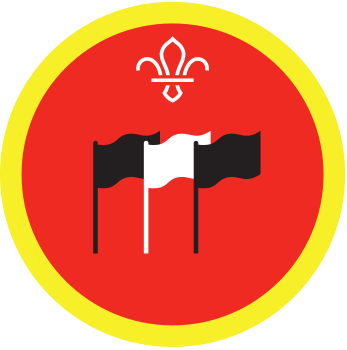
Try gauze weaving from Gaza
You’ll need
- Rulers
- Scissors
- Pens or pencils
- A4 card
- Plain white cotton fabric or white felt (approx. 30cm by 30cm)
- Surgical gauze, such as gauge bandage or gauze dressing
Before you begin
- Use the safety checklist to help you plan and risk assess your activity. Additional help to carry out your risk assessment, including examples can be found here. Don’t forget to make sure all young people and adults involved in the activity know how to take part safely.
- Make sure you’ll have enough adult helpers. You may need some parents and carers to help if you’re short on helpers.
Gauze is a fabric that has a variety of different uses. Usually, gauze is made from natural fibres such as cotton, linen and silk. It can be woven or non-woven. Woven gauze is a loose, open weave fabric, usually from cotton fibres. Non-woven gauze is made from fibres that are pressed together to resemble a wave, rather than woven.
The English word of ‘Gauze’ is thought to come from the name of the Palestinian city of Gaza, which was a centre for weaving, especially with silk. As early as the 13th Century, intricately woven silk fabric made in Gaza was exported to Europe and the rest of the world.
Initially, gauze was used for clothing, however it now has a variety of different applications.
In arts and theatre, gauze is often used in theatre. It’s loose, open weave gives the illusion that it’s translucent when lit from behind, however when lit from the front, the fabric appears to be opaque. It creates a great experience for the audience when it’s used to make a backdrop to a stage performance. Gauze, when woven with silk, is an ideal fabric to use for dresses and skirts. It’s extremely soft to the touch and holds excellent colour retention after being dyed.
When used medical purposes, gauze is made of cotton. It’s often used for bandages and surgical dressings. When woven with cotton, it doesn’t stick to open cuts or wounds. Gauze is also very absorbent, which makes it ideal for soaking up fluids too, such as blood. It’s often sold with surgical tape, which can be used to help secure the gauze dressings to the body.
Setting up this activity
- Cut out several card strips that are approximately 2-3 cm wide and 30cm in length. These can be used as a template to give out to everyone.
Run the activity
- Gather everyone together and ask if anyone knows what gauze is.
- Explain that gauze is a fabric that has a variety of different uses. Usually, gauze is made from natural fibres such as cotton, linen and silk. It can be woven or non-woven.
- Ask if anyone knows what the gauze is used for. Tell everyone that gauze can be used for lots of different things, though it was originally used for clothing. Cotton gauze now often used in medicine to help cover wounds or stop bleeding, as it’s very absorbent. It’s often used for theatre backgrounds. It’s also still used in clothing and often mixed with silk to make lightweight skirts and dresses.
- Pass around some of the gauze for everyone to feel and look at. Ask everyone to look at the design of the gauze. Can they see any patterns?
- Tell everyone that woven gauze is a loose, open weave fabric, usually from cotton fibres. Non-woven gauze is made from fibres that are pressed together to resemble a weave, rather than woven. Is the gauze you’re looking at woven or non-woven? Does it have a pattern?
- Ask if anyone can guess where the name gauze might come from. Although there is some debate, the English word of ‘Gauze’ is thought to come from the name of the Palestinian city of Gaza, which was a centre for weaving, especially with silk. As early as the 13th Century, intricately woven silk fabric made in Gaza was exported to Europe and the rest of the world.
- Tell everyone they’re going to try to weave their own gauze.
- Give everyone a 2cm x 30cm card template, a 30cm x 30cm piece of white fabric or felt, a pair of scissors and a pencil.
- First, everyone should use the card template to draw strips on the white fabric. They should fit around 14-15 strips onto the fabric.
- Once the strips have been drawn, carefully use the scissors to cut them out.
- Lay out 7 of the strips on the table or floor in front of you, then put the rest in a pile to one side.
- Take one strip from pile and start weaving. To do this, start at one side and thread it over one strip and under the next strip continuously until you reach the other end.
- Keep going with another strip but make sure it’s threaded in the opposite way to the last strip. For example, if you started the last strip with it going over, then start this strip by going under.
- Try to keep the weave as tight as possible. As you add new strips, weave them as close to the previous one as possible. Once they’re in place, you can gently push the woven strips closer together.
- Continue weaving until you use up all your strips. Once you’re finished, you can perhaps secure the strips to each other with glue or glue dots.
Reflection
In this activity, you had the chance to try weaving. Lots of things are woven, especially fabrics. Textile weaving is an ancient craft that has been around for thousands of years. It involves using threads, yarns, or fabrics made from natural or synthetic fibres to create cloth and other woven products such as carpets, curtains, tapestries, and even clothes.
Has anyone ever done weaving before? Did you enjoy weaving? What was it like? What was easy? What was tricky? Did you have any problems? How did you solve them? Did anyone help you?
We also learned about gauze and weaving. Can anyone remember anything about gauze? Why might it be useful? Why do you think gauze is sometimes woven? How might this help it or what properties might it give it?
Can you think of anything made today that is made by weaving or may have been woven in the past?
Safety
All activities must be safely managed. You must complete a thorough risk assessment and take appropriate steps to reduce risk. Use the safety checklist to help you plan and risk assess your activity. Always get approval for the activity, and have suitable supervision and an InTouch process.
- Scissors
Supervise young people appropriately when they’re using scissors. Store all sharp objects securely, out of the reach of young people.
- To make this activity easier, you could cut out the fabric strips out for everyone beforehand. You could use two different colours of felt to make the strips easier to tell apart.
- To make this activity easier, you could use paper or card strips, rather than fabric or felt strips.
- To make this activity easier, you can stick the half of the strips in a row on a piece of A4 paper. This’ll make it easier to weave the other strips in between them. You may also want to tape one or two ends of half the strips to a table or surface to keep them in place while you weave the other strips in.
- People can choose whether they’d like to pair up with someone else or work in a small group and share skills. Someone who’s great at cutting, but may struggle with weaving, could team up with someone who isn't keen on weaving, but has a great cutting the strips.
- If anyone needs help or struggles with fine motor skills, give them the opportunity to work in pairs or small groups. They could also work with a young leader or an adult volunteer. The person they’re working with can help with the parts they find fiddly to do or tricky.
- Some people might struggle with using scissors. Make sure that helpers are there to help as much as needed or have items that are pre-cut for people to use. Make sure to provide scissors everyone can use, such as left-handed, tabletop scissors, loop scissors or easy grip scissors.
- Remember to leave enough time for everyone to have a few goes at this activity, and make sure that there are plenty of adults to support everyone.
- You can adapt the thickness of the paper, so it's suitable or easier for everyone to use.
- Make sure that all the materials are at a level that can be easily worked on by wheelchair users.
All Scout activities should be inclusive and accessible.
You could try making your weaving pattern into a card to give to someone.





